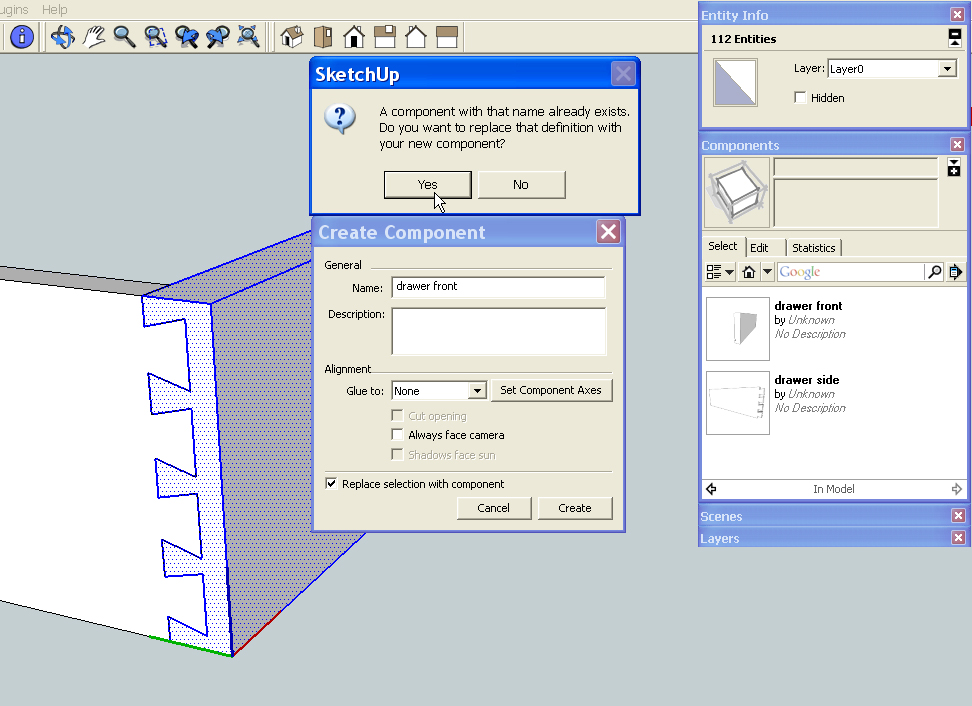

- #Create solid in sketchup manual#
- #Create solid in sketchup pro#
- #Create solid in sketchup download#
- #Create solid in sketchup free#
#Create solid in sketchup manual#
Most of them will need manual action because it is not clear how the surface was meant to be completed as a solid.

There are so many that repairing them will be quite tedious. Then you will find that the various pieces have defects such as surface borders (unclosed holes between the exterior and interior) and internal face edges. So, you will have to explode the nested groups. Although some 3d Printer slicers will accept a nested structure, SketchUp will not recognize it as a solid. For starters, it is an assembly of nested groups. Some of these components (again, notably the Voldemort head) are modeled at huge dimensions, so to use them in a model you would in any case want to shrink them down to real size.īecause it was not particularly well built, it will take a fair amount of work to make a solid from the Oscar statue. The unused components also have a number of materials associated with them, which too contribute to file size. Though not vast by SketchUp standards, those are far larger than the edge counts in the house, and (as noted) having even unused copies of them in the components collection will increase file size. Then turn on Hidden Geometry and use Solid Inspector 2 to located the bad geometry. Hide the bottom face temporarily and delete the stuff hanging down.
#Create solid in sketchup download#
It is always better to download them into an empty model and then inspect them to see whether they are suitable for your purpose and to clean them up as needed.īecause they are triangulated surfaces, the Voldemort head has almost 60000 edges, and the Oscar statue has a bit over 12000. Start by scaling the model up by 1000x so you can work on the tiny geometry.
#Create solid in sketchup free#
To learn more about the features in the Go subscription, see SketchUp for Web: Free vs. Note: The Solid Tools are also included with a Go subscription in SketchUp for Web. However, the tool that we’re interested in is the subtract tool, which allows you to delete out geometry wherever the two pieces of geometry intersect.This is a good example of the kind of problems that can arise from downloading components from the 3D Warehouse directly into your model, particularly when you don’t purge them if you aren’t going to use them. With SketchUp’s Solid tools, you can create new shapes by combining or cutting one shape with another, making it easy to model an outer shell or joinery.
#Create solid in sketchup pro#
Solid tools is a set of tools that gets included with the pro version of SketchUp – it contains a number of tools designed to help you with creating interactions with solid geometry. It basically almost just runs in the background, and when you create a cut component with depth, allows you to cut openings in multiple faces. Mindsight Studios has an extension that can cut holes in walls with multiple faces, so you could cut an opening in a wall with thickness using this extension. However, the drawback to this is that this tool only works in individual faces, not faces with any depth Then check the box for cut opening and create your component. You can make it a component that locks to faces on a specific axis, or to any geometry it touches. Simply draw a rectangle on a face, double click to select it and its edges, then right click to make a component. Right-click somewhere in the top menu bar and make sure solid tools is selected. Double click on the rectangle and select make group. Select the endpoint at the top of the shape and drag it to connect with the top endpoint of the arc in the rectangle. Using the component tools, you can create a component that cuts a hole in whatever face that it’s resting in. Double click on the shape and select make group.

Then simply delete out the remaining geometry! This will create edges where your geometry intersects. With this method, intersect a pair of shapes, then right click and select intersect with model. While the first option is the easiest, sometimes (like in the case of curved surfaces), the push/pull tool simply won’t work. However, when you start doing things with curved surfaces or surfaces that intersect, you can start running into problems. When possible, utilize this as much as possible, as it’s the simplest. Obviously simply drawing a shape on your flat objects and push/pulling it to the back to automatically delete the face is the easiest. If so, please consider supporting me on Patreon (click here to support) or by visiting my Support the Show Page! Check Out The SketchUp Essentials Course DOUBLE CUT LINK (Affiliate Link) In this video, learn 5 ways to cut holes and create openings in your SketchUp Models!ĭo you like these SketchUp tutorials and videos? 5 Ways to CUT HOLES AND CREATE OPENINGS in your SketchUp Models


 0 kommentar(er)
0 kommentar(er)
